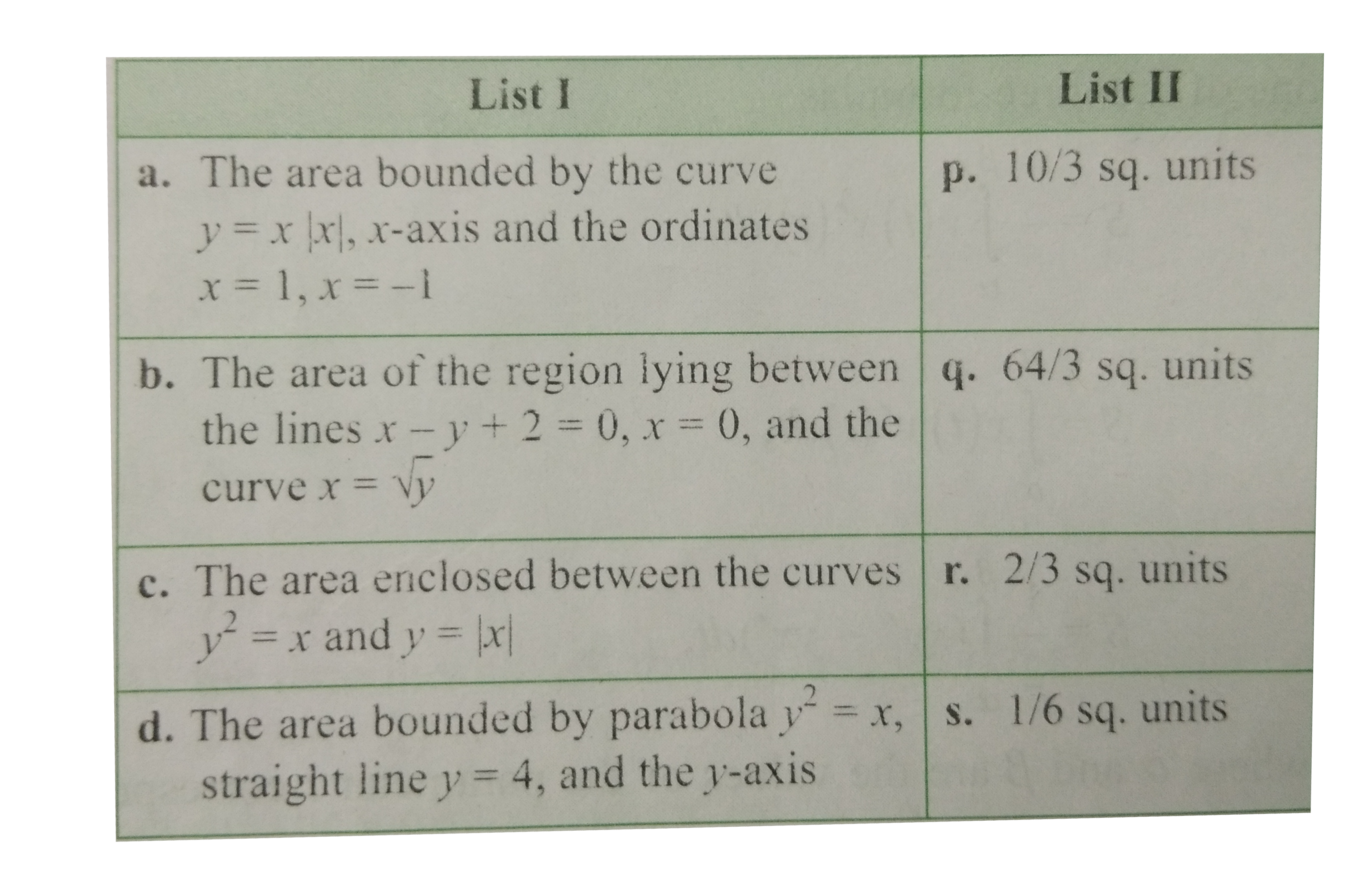Computing area with parametrically represented boundaries : If the boundary of a figure is represented by parametric equation, i.e., x=x(t),y=y(t), then the area of the figure is evaluated by one of the three formulas :
S=−∫βαy(t)x'(t)dt,
S=∫βαx(t)y'(t)dt,
S=12∫βα(xy'−yx')dt,
Where αandβ are the values of the parameter t corresponding respectively to the beginning and the end of the traversal of the curve corresponding to increasing t.
The area of the loop described as
x=t3(6−t),y=t28(6−t) is Solution in Tamil
(a)275 sq. units
(b)245 sq. units
(c)276 sq. units
(d)215 sq. units
The correct Answer is:A
6∫0(32t2−12t3+124t4)dt=32×633×12644×124655
=632−648+6420
=64(112−18+120)
=545.
∴ 126∫0(xy'−yx')dx=12×545=275 sq. units.
Topper's Solved these Questions
- BOOK - CENGAGECHAPTER - AREAEXERCISE - Exercise (Matrix)4videos
AREA
- BOOK - CENGAGECHAPTER - AREAEXERCISE - Exercise (Numerical)16videos
AREA
- BOOK - CENGAGECHAPTER - AREAEXERCISE - Exercise (Multiple)10videos
AREA
- BOOK - CENGAGECHAPTER - APPLICATIONS OF DERIVATIVESEXERCISE - Subjective Type2videos
APPLICATIONS OF DERIVATIVES
- BOOK - CENGAGECHAPTER - AREA UNDER CURVESEXERCISE - Question Bank10videos
AREA UNDER CURVES
Similar Questions
Match the following lists :
 05:11View Solution
05:11View SolutionThe area enclosed by the curve C:y=x√9−x2(x≥0) and the x-axis is___.
02:08View SolutionLet A(k) be the area bounded by the curves y=x2−3 and y=kx+2 The range of A(k) is (10√53,∞) The range of A(k) is (20√53,∞) If function k→A(k) is defined for k∈[−2,∞ ), then A(k) is many-one function. The value of k for which area is minimum is 1.
01:56View SolutionProve that for λ>1, the equation xlogx+x=λ has least one solution in [1,λ].
01:53View SolutionThe area of the region (s) enclosed by the curves y=x2 and y=√|x| is
05:45View SolutionIf y=sqrt((t-alpha)/(beta-t)) and x=sqrt((t-alpha)(beta-t)) then find (dy)/(dx)
06:14View SolutionComputing area with parametrically represented boundaries : If the boundary of a figure is represented by parametric equation, i.e., x=x(t),y=(t), then the area of the figure is evaluated by one of the three formulas :
S=−∫βαy(t)x'(t)dt,
S=∫βαx(t)y'(t)dt,
S=12∫βα(xy'−yx')dt,
Where αandβ are the values of the parameter t corresponding respectively to the beginning and the end of the traversal of the curve corresponding to increasing t.
The area of the region bounded by an are of the cycloid x=a(t−sint),y=a(1−cost) and the x-axis isView SolutionComputing area with parametrically represented boundaries : If the boundary of a figure is represented by parametric equation, i.e., x=x(t),y=(t), then the area of the figure is evaluated by one of the three formulas :
S=−∫βαy(t)x'(t)dt,
S=∫βαx(t)y'(t)dt,
S=12∫βα(xy'−yx')dt,
Where αandβ are the values of the parameter t corresponding respectively to the beginning and the end of the traversal of the curve corresponding to increasing t.
The area of the loop described as
x=t3(6−t),y=t28(6−t) isView SolutionComputing area with parametrically represented boundaries : If the boundary of a figure is represented by parametric equation, i.e., x=x(t),y=(t), then the area of the figure is evaluated by one of the three formulas :
S=−∫βαy(t)x'(t)dt,
S=∫βαx(t)y'(t)dt,
S=12∫βα(xy'−yx')dt,
Where αandβ are the values of the parameter t corresponding respectively to the beginning and the end of the traversal of the curve corresponding to increasing t.
If the curve given by parametric equation x=t−t3,y=1−t4 forms a loop for all values of t∈[−1,1] then the area of the loop is03:25View SolutionComputing area with parametrically represented boundaries
If the boundary of a figure is represented by parametric equations x = x (t) , y = y(t) , then the area of the figure is evaluated by one of the three formulae
S=−∫βαy(t)x'(t)dt,S=∫βαx(t)y'(t)dt
S=12∫βα(xy'−yx')dt
where α and β are the values of the parameter t corresponding respectively to the beginning and the end of traversal of the contour .
The area of ellipse enclosed by x = a cos t , y = b sint (0≤t≤2π)03:46View SolutionComputing area with parametrically represented boundaries
If the boundary of a figure is represented by parametric equations x = x (t) , y = y(t) , then the area of the figure is evaluated by one of the three formulae
S=−∫βαy(t)x'(t)dt,S=∫βαx(t)y'(t)dt
S=12∫βα(xy'−yx')dt
where α and β are the values of the parameter t corresponding respectively to the beginning and the end of traversal of the contour .
The area enclosed by the astroid (xa)23+(ya)23 = 1 is04:50View SolutionComputing area with parametrically represented boundaries
If the boundary of a figure is represented by parametric equations x = x (t) , y = y(t) , then the area of the figure is evaluated by one of the three formulae
S=−∫βαy(t)x'(t)dt,S=∫βαx(t)y'(t)dt
S=12∫βα(xy'−yx')dt
where α and β are the values of the parameter t corresponding respectively to the beginning and the end of traversal of the contour .
The area of the region bounded by the an arc of cycloid x = a(t−sint),y=a(1−cost) and the x-axis06:28View SolutionIf the boundary of figure is represented by parametric equations i.e. x = x (t), y = y (t), then the area of the figure is evaluated by one of the three formulas
S=−β∫αy(t)x'(t)dt, S=β∫αx(t).y'(t)dt
S=12β∫α(xy'−yx')dt where α and β are the values of the parameter t corresponding respectively to the beginning and the end of of the traversal of the curve corresponding to increasing t
The area enclose by the asteroid (xa)z/3+(ya)2/3=1 is03:29View SolutionComputing area with parametrically represented boundaries : If the boundary of a figure is represented by parametric equation, i.e., x=x(t),y=(t), then the area of the figure is evaluated by one of the three formulas :
S=−∫βαy(t)x'(t)dt,
S=∫βαx(t)y'(t)dt,
S=12∫βα(xy'−yx')dt,
Where αandβ are the values of the parameter t corresponding respectively to the beginning and the end of the traversal of the curve corresponding to increasing t.
The area of the region bounded by an are of the cycloid x=a(t−sint),y=a(1−cost) and the x-axis is05:44View SolutionComputing area with parametrically represented boundaries : If the boundary of a figure is represented by parametric equation, i.e., x=x(t),y=(t), then the area of the figure is evaluated by one of the three formulas :
S=−∫βαy(t)x'(t)dt,
S=∫βαx(t)y'(t)dt,
S=12∫βα(xy'−yx')dt,
Where αandβ are the values of the parameter t corresponding respectively to the beginning and the end of the traversal of the curve corresponding to increasing t.
The area of the loop described as
x=t3(6−t),y=t28(6−t) is08:50View Solution

